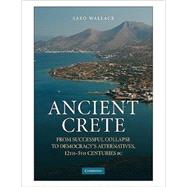
Note: Supplemental materials are not guaranteed with Rental or Used book purchases.
Purchase Benefits
What is included with this book?
| Crete Between East and West, State Collapse, and State Emergence: | |
| Introduction | |
| Method and structure | |
| Text perspectives | |
| Chronology, terminology, and dating methods | |
| The Late Bronze Age Cretan landscape and its use | |
| The broader framework: structures of landscape use by the LBA-EIA transition | |
| 'Positive' Collapse and Its Effects, c.1200-1000 BC: The Restructuring of Space and Place: | |
| Approaches to studying collapse - explanation and characterization | |
| The changing use of space: introduction | |
| Settlement pattern in Crete | |
| Subsistence in the new settlement environment | |
| Settlement change outside Crete: islands and peninsulas | |
| Mainland central Greece: settlement priorities during and after collapse | |
| Constructing post-collapse society: inside Cretan settlements, c.1200-1000 BC | |
| Ceremonial and ritual practice within settlements | |
| Beyond settlements: the changing cultural landscape | |
| Mortuary space and practice in Crete and other areas | |
| The structure of collapse in Crete | |
| After the Fall: Interactions with Other Mediterranean Regions in the Twelfth to Eighth Centuries BC: | |
| Introduction | |
| Long-distance contacts before and after the collapse horizon, c.1300-1000 BC | |
| The social role of exotica | |
| Exchange structures inside post-collapse Crete | |
| Lift-off: east Mediterranean trade and the central Aegean from the tenth century | |
| Nothing to declare? - Crete in the tenth through eighth centuries | |
| Modes and routes of exchange within Crete in the later EIA | |
| Crete's membership in the 'orientalising' and colonial worlds from the seventh century | |
| 'Proto-poleis'? - The Growth of Social Complexity in Crete from the Tenth through the Seventh Centuries: | |
| Main sources of evidence discussed | |
| Settlement patterns (1): the nucleation phenomenon | |
| Settlement patterns (2): small sites and small-group identity | |
| Subsistence and land-use in the expanding polities | |
| Inside settlements | |
| The mortuary record | |
| The ritual landscape and the construction of political identity | |
| The early Archaic horizon: correlates of state development and growth in the archaeological record | |
| The polis as place and as concept in Crete | |
| The value of 'classic' state formation models to PG-early Archaic Crete, viewed in its Mediterranean context | |
| Constructing Difference: The History, Structure, and Context of Cretan States in the Later Archaic through Classical Periods: | |
| Introduction | |
| Problems in generalization and comparison | |
| The central Greek polis structure over time: tensions between tyranny/kingship and participative governance | |
| Special aspects of the Archaic to Classical Cretan polis | |
| Cretan identities in historical perspective | |
| Serfdom and slavery in the construction of Late Archaic to Classical society: comparisons between Crete and other Aegean areas | |
| The public feasting tradition and its political significance in Crete and other areas | |
| A final comparison: democracy and its alternatives in the Aegean world | |
| Table of Contents provided by Publisher. All Rights Reserved. |
The New copy of this book will include any supplemental materials advertised. Please check the title of the book to determine if it should include any access cards, study guides, lab manuals, CDs, etc.
The Used, Rental and eBook copies of this book are not guaranteed to include any supplemental materials. Typically, only the book itself is included. This is true even if the title states it includes any access cards, study guides, lab manuals, CDs, etc.